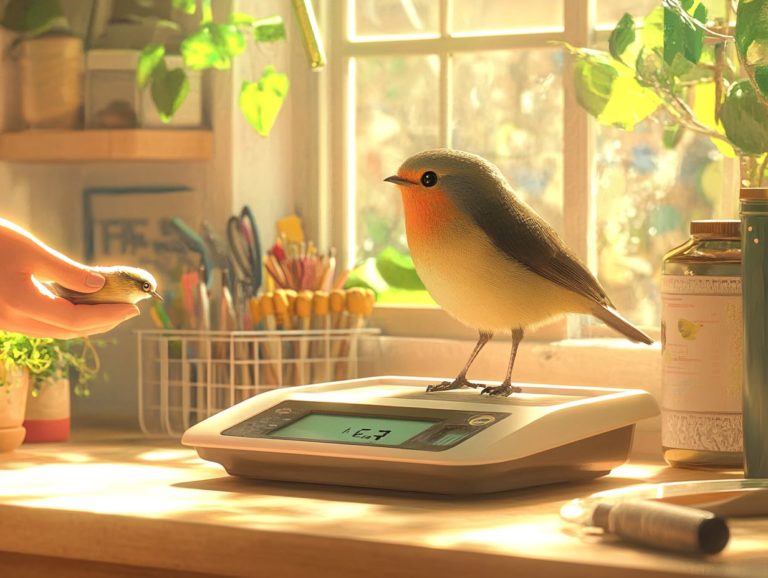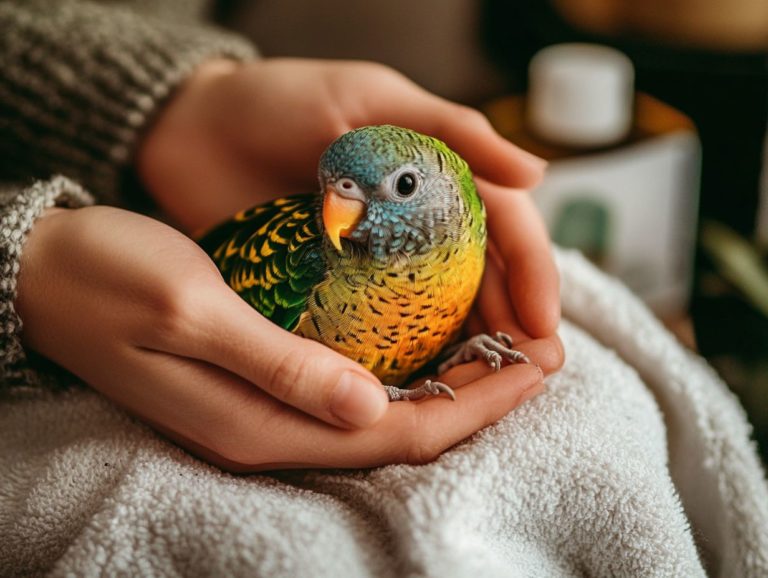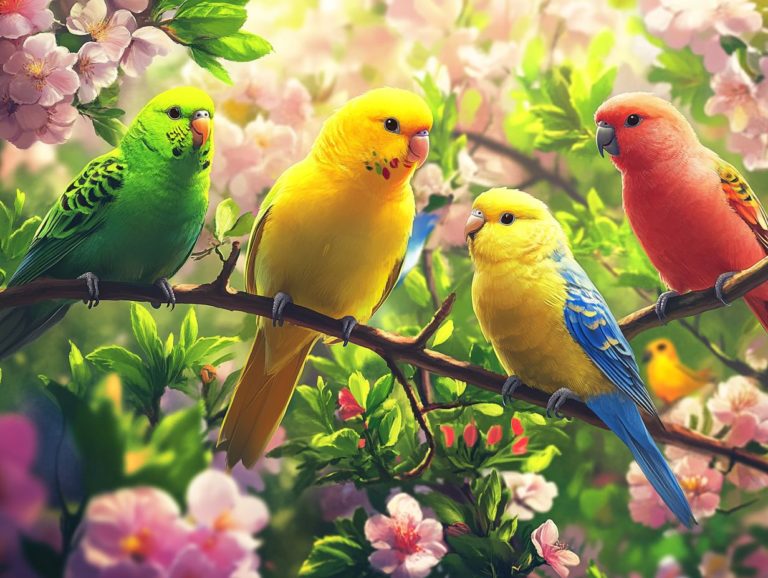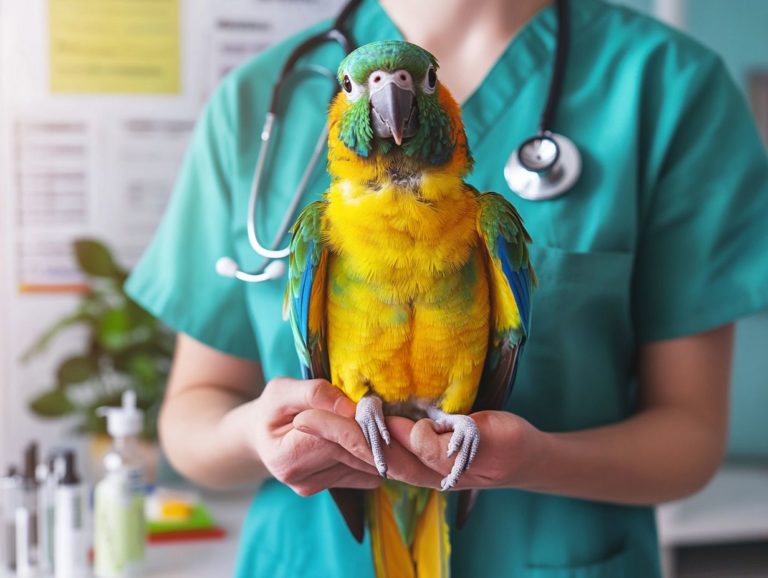The Connection Between Environment and Bird Health
Birds are truly remarkable creatures, playing essential roles in our ecosystems. Their health is closely connected to the environments they inhabit.
However, various factors like pollution, habitat destruction, and climate change pose significant threats to their well-being.
In this exploration, you will uncover the signs of poor bird health, identify common environmental challenges, and discover practical ways to promote healthier habitats.
Whether you re an avid birdwatcher or simply someone who cares about wildlife, understanding this connection can inspire you to take meaningful action right in your own backyard.
Contents
- Key Takeaways:
- The Impact of Environment on Bird Health
- Common Environmental Factors Affecting Birds
- Signs of Poor Bird Health
- How to Promote Healthy Environments for Birds
- You Can Protect Bird Health in Your Own Backyard!
- Frequently Asked Questions
- What is the connection between environment and bird health?
- How does pollution in the environment affect bird health?
- What are some ways to create a bird-friendly environment?
- Can climate change affect bird health?
- How can human activities impact the environment and bird health?
- What can people do to help protect the environment and promote bird health?
Key Takeaways:

- Pollution and habitat destruction pose major threats to bird health, leading to decreased populations and increased susceptibility to disease.
- Climate change is a significant factor, causing shifts in bird habitats and disrupting food sources.
- Conservation efforts and creating bird-friendly environments in our backyards can play a crucial role in promoting the health of our feathered friends.
The Impact of Environment on Bird Health
The well-being of birds is closely connected to their environments. Understanding bird behavior and the health indicators related to factors such as habitat loss, pollution, and climate change is critical for assessing their health.
Understanding these relationships is essential. Birds signal the overall vitality of ecosystems and fulfill vital roles in ecological functions, including pest control and nutrient transfer.
Recognizing their importance sparks a connection to nature! They enhance our quality of life and support the intricate processes of the natural world.
Understanding the Relationship
Exploring the relationship between birds and their environments unveils the intricate balance of ecosystem services that avian species provide, such as pest control and seed dispersal.
These contributions are vital for maintaining biodiversity and ensuring the health of natural systems. For example, the Barn Owl plays a crucial role in keeping rodent populations in check. The Blue Jay helps disperse oak seeds, supporting forest regeneration.
However, habitat loss driven by urbanization and climate change harms these birds, leading to declines in certain populations. When species dwindle, it serves as a crucial warning signal for the overall health of their ecosystems.
This highlights the urgent need to protect their habitats, not just for the birds themselves but for the stability of the environment as a whole.
Common Environmental Factors Affecting Birds
Common environmental factors impacting birds include habitat loss, pollution, and climate change. Each of these presents substantial threats to avian species and their populations worldwide.
Pollution and Habitat Destruction
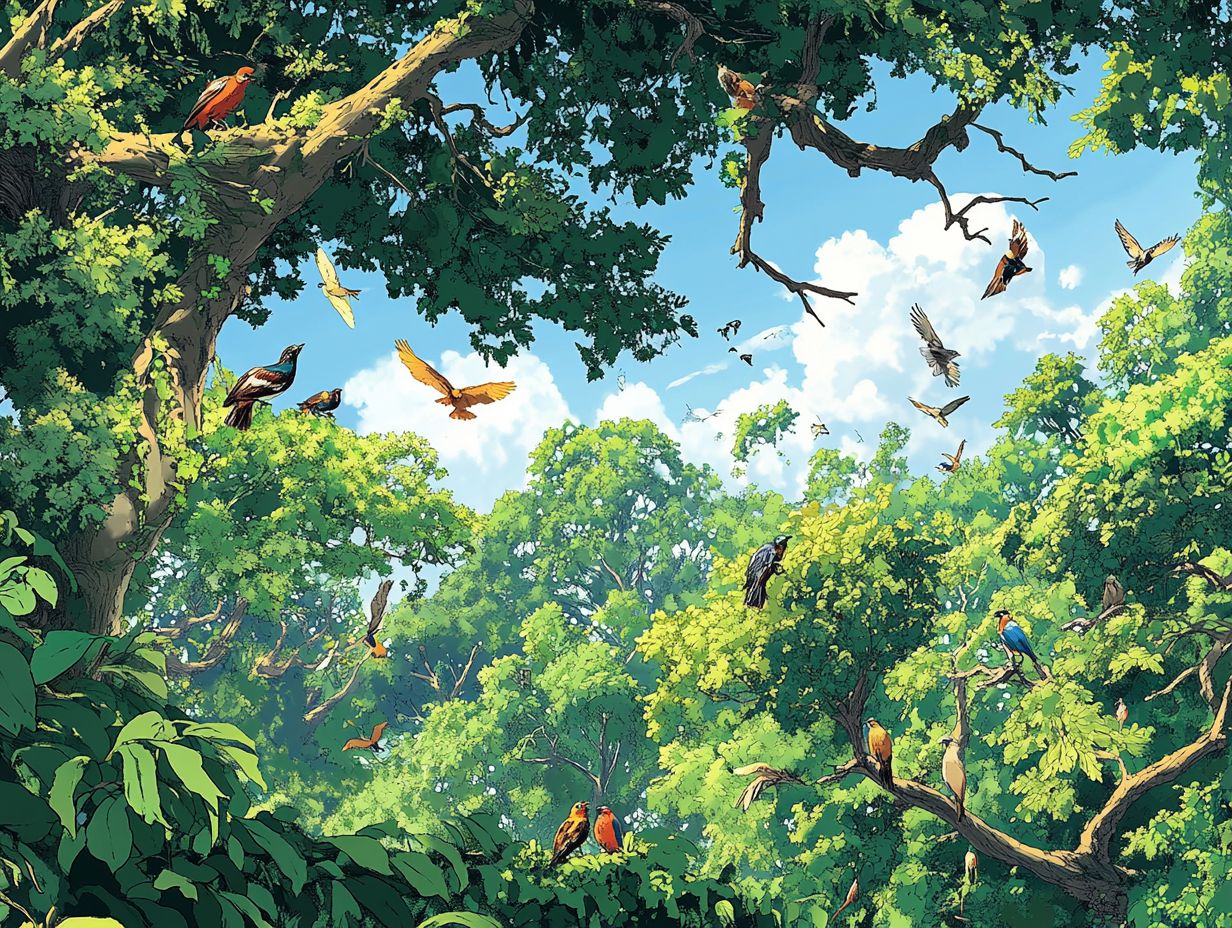
Pollution and habitat destruction are wreaking havoc on bird populations, significantly diminishing the diversity and health of avian species.
These environmental threats take many forms, particularly through chemical runoff that taints waterways and plastic waste that clogs essential habitats. Such pollutants contaminate food sources and pose direct health risks to birds, whether through ingestion or entanglement.
Case studies involving seabirds in the North Pacific illustrate how discarded fishing gear and microplastics disrupt feeding habits and nesting behaviors. Furthermore, habitat destruction from urban development and deforestation compounds these issues by reducing the availability of essential nesting sites and food resources, ultimately jeopardizing the survival of countless bird species.
Join conservation efforts in your community to help combat these challenges!
Climate Change
Climate change presents a significant threat to bird populations by transforming their habitats and disrupting migration patterns worldwide. As temperatures rise and weather becomes increasingly unpredictable, various bird species are struggling to keep pace with these changes.
Take the Greater Honeyguide, for example. This remarkable bird is known for its unique partnership with honey-hunting humans. It faces serious challenges due to shifting vegetation patterns and reduced food availability.
Similarly, Barn Swallows are grappling with changes in their migratory timing. This could result in mismatches in food supply during crucial breeding seasons. Scientific studies, including those featured in Science Advances, emphasize the urgent necessity for conservation efforts specifically designed for these vulnerable species.
It s essential to implement protective measures now to prevent further irreversible impacts on their populations.
Signs of Poor Bird Health
Signs of poor bird health can manifest in various ways. This includes declining populations and clear signs affecting avian species. These indicators reflect the challenges birds face in adapting to environmental changes.
Identifying Symptoms and Causes
Identifying the symptoms of poor bird health requires keen observation of behaviors and conditions that might hint at underlying issues, such as habitat stress and pollution exposure.
When you notice birds displaying lethargy, feather loss, or unusual vocalizations, they may be signaling distress linked to their deteriorating environments. For instance, the sharp decline of song sparrows in urban areas often traces back to increased noise pollution and habitat fragmentation, which disrupt their essential communication and breeding patterns.
If you see the once-vibrant plumage of a goldfinch dulled in a toxic environment, it s a clear indication of exposure to harmful pollutants like heavy metals. Migratory species like the American redstart face unique challenges. Their reliance on specific habitats during migration makes them particularly vulnerable to habitat loss and environmental degradation.
By paying close attention to these signs, you can gain a deeper understanding of the intricate relationship between avian health and their ever-changing ecosystems.
How to Promote Healthy Environments for Birds

Promoting healthy environments for birds requires proactive conservation actions that focus on restoring habitats and nurturing wildlife coexistence within our natural ecosystems. Your efforts play a crucial role in ensuring that these avian communities thrive alongside the diverse life that surrounds them.
Conservation Efforts and Best Practices
Conservation efforts aimed at birds involve a range of best practices designed to enhance their habitats and support the health and diversity of avian species.
Programs spearheaded by wildlife organizations such as PMC and Partners in Flight showcase effective restoration strategies. These initiatives often utilize methods like reforestation, wetland restoration, and the establishment of wildlife corridors, all crucial for habitat recovery.
By focusing on the protection of specific ecosystems, they cultivate environments that are ideal for breeding and feeding. Continuous monitoring of bird populations is essential; it enables conservationists to evaluate the success of these initiatives and refine strategies as necessary to ensure enduring achievements.
This comprehensive approach is vital for preserving the delicate balance within bird habitats.
You Can Protect Bird Health in Your Own Backyard!
You can make a big difference for local bird populations right in your own backyard! By creating a bird-friendly environment, you foster a harmonious coexistence with wildlife and enhance the beauty of your surroundings.
Act now to create a bird-friendly environment and help them thrive!
Tips for Creating a Bird-Friendly Environment
Creating a bird-friendly environment is easier than you might think. It involves straightforward yet impactful steps to restore habitats and support local bird species in your area.
By embracing these practices, you can cultivate a thriving sanctuary for birds. This not only enhances your space but also contributes to greater biodiversity. Selecting native plants is essential because they provide vital food and shelter for birds. You ll be amazed to see how quickly bird populations increase when you implement these strategies!
For example, butterflies and other insects that serve as food sources flourish on native flora, keeping nature healthy.
Nesting boxes act as secure havens for various species. They offer a peaceful place for birds to raise their young. Evidence shows that backyards implementing these strategies see a noticeable increase in bird populations. It’s crucial to eliminate harmful chemicals that can drive birds away.
Simple changes can significantly improve the environment for birds. Just a few native shrubs and a thoughtfully positioned nesting box can transform your backyard into a vibrant haven for avian life.
Frequently Asked Questions
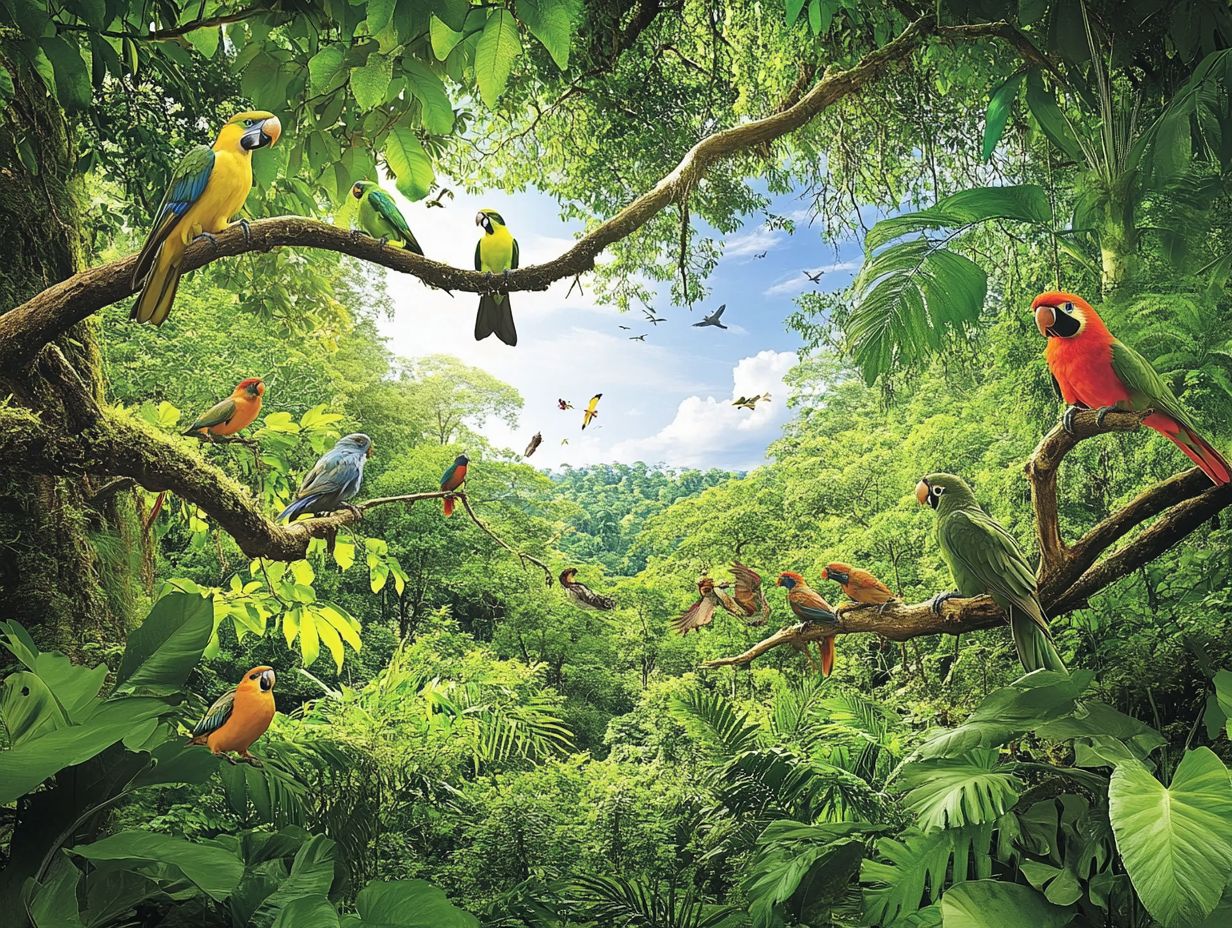
What is the connection between environment and bird health?
The environment plays a crucial role in the overall health and well-being of birds. Their habitat, food sources, and exposure to contaminants all impact their physical and behavioral health, including the impact of temperature on bird health.
How does pollution in the environment affect bird health?
Pollution, including air and water pollution, negatively impacts bird health. It can cause respiratory problems, reduce their food sources, and increase their risk of disease.
What are some ways to create a bird-friendly environment?
Planting native plants and providing clean water sources are effective strategies. Additionally, limiting the use of pesticides helps create a healthier environment for birds. These changes will help them thrive and maintain their populations.
Can climate change affect bird health?
Yes, changes in climate can significantly impact bird populations. Warmer temperatures can alter migration patterns and disrupt breeding cycles, leading to a decline in bird populations.
How can human activities impact the environment and bird health?
Human activities, such as deforestation, urbanization, and pollution, directly impact bird habitats and food sources. These changes disrupt the natural balance of ecosystems and harm bird populations.
What can people do to help protect the environment and promote bird health?
Many things individuals can do help protect the environment and promote bird health. This includes reducing the use of single-use plastics, supporting conservation efforts, and advocating for more sustainable practices. Every small action can make a difference in preserving the environment for birds and other wildlife.
Join us in making a difference today! Together, we can work towards a healthier environment for birds and future generations.



